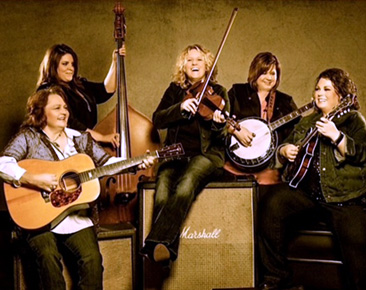
This recent interview with Sister Sadie is a contribution from Nancy Cardwell, long time employee and former Executive Director of the IBMA, and noted bluegrass writer and performer.
 Although the official release date for the self-titled debut Sister Sadie album from Pinecastle Records isn’t until tomorrow, June 3, the first radio single, Unholy Water, is already receiving widespread airplay. There’s something special about this song, written from the seductive perspective of moonshine, personified here by songwriters Deanie Richardson and Bill Tennyson as “the devil’s daughter.”
Although the official release date for the self-titled debut Sister Sadie album from Pinecastle Records isn’t until tomorrow, June 3, the first radio single, Unholy Water, is already receiving widespread airplay. There’s something special about this song, written from the seductive perspective of moonshine, personified here by songwriters Deanie Richardson and Bill Tennyson as “the devil’s daughter.”
There’s also something special about this band. Reminiscent of the Bluegrass Album Band, Sister Sadie has the same blow-your-hair-back, traditional drive that puts real deal bluegrass fans on shouting ground, with original material that provides an extra bonus. Like Doyle, Tony and them, Sister Sadie is a new combination of veteran musicians and singers who are also old friends, at the top of their game musically. Five-time IBMA Female Vocalist of the Year, Dale Ann Bradley and Tina Adair—both leaders of their own individual bands—provide lead and tenor vocals. The star of Star, North Carolina, Gena Britt (currently touring with Alan Bibey & Grasstowne) is widely respected for her authoritative right hand on the five-string banjo as well as her vocal chops. She sings the most gorgeous baritone in bluegrass music, in this band. Deanie Richardson (The Chieftains, Patty Loveless, Bob Seger, The Coon Creek Girls, and sub fiddler for the Grand Ole Opry house band), is simply one of the best fiddlers in bluegrass and country music today. Beth Lawrence, from the bluegrass state of Wisconsin and now a Nashville-based, first call bassist for bands too numerous to list here, creates a solid sonic foundation for the band.
Alison Krauss says this: “Sister Sadie is an inspiring musical collaboration bringing together some of the best women bluegrass music has ever claimed.”
“I’m glad someone claims us,” Beth Lawrence cracks, sending the other two members of the band into gales of laughter at a recent interview for Bluegrass Today.
Sister Sadie got together for the first time three years ago, for a gig at Christmas time in Nashville. “We rehearsed in the Station Inn the afternoon before we played,” Tina Adair recalls, “and from the first note we hit, we knew it was something special. It just felt good. The chemistry was real good.”
It went so well that the ladies resolved to play together once a year. Then some cell-phone videos from fans started to circulate and calls came in for more bookings. “Then we went back to the drawing table and said, ‘Well, maybe we should consider forming this and doing it more seriously than once a year at the Station Inn,’” Adair says.
This particular combination of voices and instruments feels magical onstage, Deanie Richardson says. “And it’s not just the first time we played, but every single time we get together and play that first note. It’s that drive when Gena’s banjo kicks off the first song, and the mandolin chop comes in….”
“It give me cold chills, just talking about it,” Adair says. “I was thinking about this, driving down the road the other day—how much of an honor it is to play with such talented musicians. I would say ‘women,’ but really, I don’t want to throw anything gender-specific in there. It’s just great musicianship and comradery and respect for each other.”
Adair admits to getting a bit mind-boggled when she thinks about everyone Richardson has performed with over the years, “and the same way with Dale Ann,” she says. “Working with Dale Ann pretty closely during the past three or four years on her last project and now this, it’s almost like she’s become a mentor for me, watching how she takes a song and makes it her own. I don’t take this opportunity for granted, and it’s amazing when I stop and think about it. One day I’m going to look back and say, ‘My gosh, I was in a band with these women!’”
Sister Sadie music isn’t light and fluffy, feminine bluegrass. These ladies can consistently pull off a “hold on for dear life” groove akin to a powerful steam engine barreling down the track. “We do try to keep it pretty traditional,” Deanie says. “You don’t hear a lot of traditional chick bluegrass bands,” she smiles, “although I was in the New Coon Creek Girls and we did a few traditional songs. It’s fun to play the hard-driving bluegrass that the guys play, and play it well. We’ve got Gena in there with that right hand (on banjo) and we’re able to tackle that. We’re not sissies. It’s not pretty bluegrass. We’re gonna kill somebody before it’s over,” she deadpans—referring to the lyrics of songs like Blood Red and Goin’ Down, track #12 on their new album.
Encouraged by the reception they’re getting on stages nation-wide as well as the big fun going on onstage, the members of Sister Sadie are taking their new collaboration more seriously. “We’re excited about moving forward as a band and opening up a few more dates a year,” Deanie says. “It’s something we’re open to exploring, more than we originally thought we would.”
They have a list of places they’d like to play. Deanie would like to land Sister Sadie—named for a combination of the Shawn Camp/Guy Clark song, Sis Draper and Tony Rice’s Little Sadie—on the Grand Ole Opry stage. “Tina’s the only one who hasn’t played the Opry yet, and I’d love to make that happen for her.”
“There are a lot of other bands we all play in, with interesting music,” Beth Lawrence says, “but this is SO fun.”
“It’s pretty much laughter, from when we first get together until the door shuts when we leave,” Deanie says. “We enjoy being together, period, and that carries over onstage—where we mean business. It’s the whole package.”
The Scoop on the Band Members:
 Sister Sadie is not a mutual admiration society, but they all do truly respect each other’s contributions to the whole that is bigger than the sum of individual parts. Dale Ann Bradley possesses one of the most uniquely beautiful, powerful voices in bluegrass or country music. Her peers know this as well as her fans. “There’s never gonna be another Dale Ann,” Tina says simply. “She’s very musically savvy,” Richardson adds. “If you don’t know her well, you may not realize what a genius she is in the studio at arranging songs. She’s very tasteful; she knows what’s going to work for a song, and what’s not going to work. She’s pretty dang clever, to be an East Kentucky girl,” Deanie jokes.
Sister Sadie is not a mutual admiration society, but they all do truly respect each other’s contributions to the whole that is bigger than the sum of individual parts. Dale Ann Bradley possesses one of the most uniquely beautiful, powerful voices in bluegrass or country music. Her peers know this as well as her fans. “There’s never gonna be another Dale Ann,” Tina says simply. “She’s very musically savvy,” Richardson adds. “If you don’t know her well, you may not realize what a genius she is in the studio at arranging songs. She’s very tasteful; she knows what’s going to work for a song, and what’s not going to work. She’s pretty dang clever, to be an East Kentucky girl,” Deanie jokes.
“I’ve never seen anyone be sick in the studio, lying on the floor, and then get up and sing like an absolute angel,” Beth marvels. “She’s written some of my favorite songs,” Adair notes. “She’s funny too, although she doesn’t try to be at all. She keeps us entertained, and doesn’t even know that she does, just with the things she says.”
Regarding Gena Britt’s prowess on the five, Deanie says,” There’s no better right hand that I’ve ever played with. And her timing—her sense of holding this thing together and moving it forward, is so good.”
“Gena is like a metronome herself,” Adair adds. “She’s just incredible, and her baritone singing is wonderful. Tim Austin produced this album, and when he was mixing the vocals he said, ‘Man, most of the time I just mix the baritone part loud enough to where you can hear it, but Gena’s voice is so full on that bottom end, I keep wanting to raise it up and raise it up.’”
“Gena is also one of the sweetest, classiest human beings you’ll ever meet,” Richardson says.
Bass player Beth Lawrence is appreciated for her skills as a licensed massage therapist as well as a superlative musician. “She holds us all together,” Richardson says. “I think Beth is an incredible bass player, and I think Beth’s a great singer too. She’s got a sweet, sweet, tender voice. Plus, she’s funny as hell. If you Google the airplane scene of the movie, Bridesmaids, that right there will sum up about 75% of the trips with Sister Sadie,” she confides.
Regarding Tina Adair’s vocals, Beth says, “I don’t think I know anyone who is so well rounded and can pull from so many different places vocally. Dale Ann can do any move she wants to, but Tina can almost do any sound she wants to. They’re both such great, trained singers. She’s also complementary to other singers; she sounds like Dale Ann’s sister when they sing together. There’s kind of this magic, with their two voices together and Gena underneath.”
“And she’s a much better mandolin player than she thinks she might be,” Deanie adds. “She’s really good.”
“Well, her fiddle tune that she wrote for the album about made me lose my religion and my mandolin, all at the same time,” Adair laughs. Ava’s Fury was inspired by a temper tantrum Deanie’s eight year old step-daughter threw one afternoon at the house. (Imagine a modal tone in A, with a flurry of fast-paced, angry musical phrases.)







